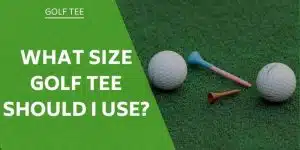The main reason for golf ball marking is to identify your ball on the odd occasion that it goes astray or you end up in the rough. Ball markings are also used for personal, corporate, or charity branding. Ball alignment is another reason.
This concept sounds simple yet it is quite a contentious subject.
You may ask why golf ball marking is such a controversial subject since most professional and amateur golfers use markings on their golf balls as identification and alignment aids.
The two schools of thought are both based on the rules of golf.
Marking Your Golf Ball
Rules of golf do not compel you to add any markings on your golf ball. However, it is highly recommended in Rule 6-3a that states: “The responsibility for playing the proper ball rests with the player. Each player should put an identification mark on his ball.”
This is not an enforceable rule but serves as a guideline to enable you to identify your ball and thus avoid penalties. Playing the wrong ball is a major sin on the golf course.
Golfers and manufacturers have added markings on the ball to aid in the alignment of the ball, especially on the green. This helps many players with their drives and putting.
Prohibiting Alignment Line Marking
Rule 10-2b (2) reads “The player or caddie must not set an object down anywhere on or off the putting green to show the line of play.” Many believe that an alignment mark added to the golf ball disrespects the spirit of Rule 10-2b as it cannot be removed before the putt is made.
They contend that the definition of an object is “a material thing that can be seen and touched”. Since you can both touch and see an alignment line, it must be deemed an object.
This is disputed by the rule makers that disagree that marking with a sharpie or manufacturer logo is an object therefore and thus no breach of 10.2b (2).
Complications are encountered when Rule 10.2b (2) is read with Rule 6-3a in the Rules of Equipment that “encourages the player to put an identification mark on his or her ball to help ensure that he or she plays their ball throughout the round. There are no regulations to limit what or how many markings can be applied to the ball by the player, provided its original markings can be discerned.”
I will leave it up to you to decide which of these camps you will support.
Why Mark Your Ball?
As stated before, Rule 6-3a encourages you to mark your golf to ensure you can identify and play your ball. Should you find a ball in a hazard but are unable to positively identify it, you have to declare a lost ball with the related penalty of stroke and distance rather.
Playing someone else’s ball will encounter a 2 stroke penalty in stroke play and the loss of a hole in match play. The penalty can be applied more than once on a hole if you continue to play the wrong ball.
In addition to making it easier to identify, there is a multitude of other reasons to mark your golf balls such as personalization, marketing, and more.
What do the Pros do?
Professional golfers, just like amateurs, do hit the ball offline on occasion and have to identify their golf balls. You have access to the same tools as they use. See below for some ideas of how some of the best golfers mark their golf balls.
Jordan Spieth
To increase his concentration, Jordan Spieth marks his ball with a ‘Z’ as a reminder that he must “zero in” on his target, but he does not have a specific alignment mark for putting.
He uses the number on the ball in the opposite direction than it is numbered. Balls marked as a four is used in round one and then decreases as the rounds accumulate. The number one is only used in the fourth round of a tournament.
Louis Oosthuizen
Major winner Louis Oosthuizen uses the initials of his family members on the side of his ball, and a small dot next to the number. Oosthuizen says he likes to look down on a blank white surface, so places his ball with the markings facing down and to the sides.
Bubba Watson
Bubba is known for his support of breast cancer and the use of a pink driver. He uses a pink pen to draw a large circle next to the number and the stamp on the side of the ball for alignment.
Bernd Weisberger
He marks his ball in the colors of his hometown, blue, black, and white. First, he adds a couple of dots next to the logo and a blue dot above the number of the ball.
Danielle Kang
Danielle marks her ball with a thick black line on one side and a dot on the opposite side. This enables her to identify the ball even if it lands on the line.
Viktor Hovland
Viktor is one of the rising stars on the PGA tour and keeps the marking of the ball rather straightforward. He draws a short line on the ball which he uses for alignment on the green.
Tools to Mark Your Golf Balls
Nearly all manufacturers add numbers to their golf balls enabling you to identify your ball if your playing partners play the same brand. You must check that no one else in your group is using the same number if your ball does not contain other identifying marks.
Permanent Markers
The simplest and most flexible way of marking your golf ball is by using a permanent marker. Markers are available in a variety of sizes that can fit in your golf bag to mark a ball while on the course.
This allows you to place any mark that you deem to enable you to identify your golf ball anywhere on your ball.
Many golfers fill specific dimples on the golf ball, and I fall in this category. I mark two dimples on either side below the branding creating a smile. This reminds me to have fun while playing golf.
There are many templates available that you can use in combination with a sharpie to leave a pattern of your choice on the ball.
The best permanent markers offer a consistent flow that does not bleed, dry out or smear.
Personalized Golf Ball Stamp
Personalized golf ball stamps allow you to mark your golf ball with a marking that you can personalize for easy identification.
These golf ball stamps utilize permanent ink to create a smudge-free and waterproof imprint on your golf ball.
You can personalize the stamp to contain your name or initials, the course, company name, or similar unique patterns provided it will fit within a 3/8 inch circle on a golf ball. I still have a collection of golf balls used at golf days that I attended.
Another reason for marking is adding a commemorative design to identify the ball you used for your first hole-in-one, breaking 100, or the first Pro-Am tournament you were invited to.
Alignment
Adding alignment marks on your golf ball is a controversial area within the golfing community.
The rules allow you to add any mark that you require to identify the ball and many golfers make use of this to add alignment marks.
Manufacturers generally use the name of the specific ball in the range to form an alignment indicator.
Personal preference will dictate the alignment mark that ends up on your ball. Some players prefer a thin line while others prefer a thick line. Some prefer a short line while others prefer the line to circumnavigate the ball.
The most common alignment markings are:
Straight Line
A straight line with or without a pointer, whatever thickness you may prefer is acceptable. However, you are not limited to a line. Any combination of characters that enables you to line up the golf ball is acceptable.
Place the ball and align it with the alignment on your putter, select your spot on the green, then pull the trigger. You are much likelier to hole puts this way.
The “T” Line
If you need some more assistance than just having a straight line, you can add a line on the golf ball to form a “T”. This will enable you to square your putter face for enhanced alignment.
The Lone Dot
Should you want to concentrate on a specific area on the golf ball you can put a dot on the ball and once aligned, concentrate on the spot until impact.
Finding the Sweet Spot
The golf ball manufacturing process is not flawless. The sweet spot varies in every ball affecting your speed and distance if not struck perfectly.
Some golf ball-marking tools use a type of centrifuge to locate and identify the sweet spot on any golf ball. Once that spot has been identified, the tool systematically creates a mark around the circumference of the ball that is perfectly aligned with that sweet spot.
An electronically-located sweet spot utilizes spin-balance technology to locate the sweet spot within 40 seconds or less by electronically calibrating finding a perfect balance line. This assists you with alignment and precision.
Final Thoughts
Marking your golf ball is a tool to ensure that you can identify your golf ball and avoid penalty strokes. It can make your alignment on the tee, fairway (when placing is allowed), and on the green much simpler.
Although some golfers consider this as controversial, it is widely accepted and recommended. Your imagination, and the size of the golf ball, are the only limitations to what you can put on the golf ball.
If you have any comments please add them in the area below.
- Best Golf Balls for Low Handicap; Move To A Single-Digit Handicap
- 8 of The Best Golf Balls For The Average Golfer; Which Come Out On Top?
- Why Do Golf Balls Have Dimples? Your Golfing Questions Answered
Nick is the founder of GolfSpan and an avid golfer. He's not quite a pro but has over 15 years of experience playing and coaching golfers worldwide. His mission is to bring the golfing community a better experience when it comes to choosing the right golf gear and finding the right setup for your game.






